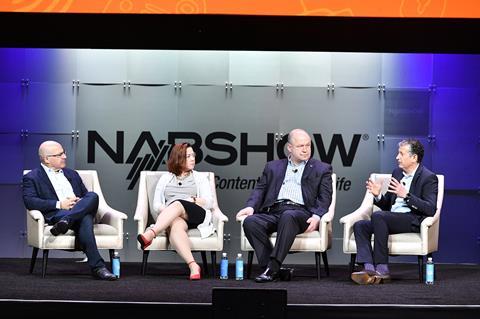From the creation of content in the cloud to the delivery of content to mobile devices, NAB 2019 was awash with innovation that suggests an even closer relationship between the media and telco industries.
The annual NAB gathering in Las Vegas was timely, given that it was bookended by Apple’s confirmation in March of its streaming plans and then Disney’s SVOD service, which was announced on the last day of NAB at a separate US event.

Aptly, given that we are in a golden age of content with consumers spoilt for SVOD services and many more set to launch over coming months, the theme of NAB 2019 was storytelling, with providers seeking to differentiate through original content and a seamless viewer experience in an effort to create the next biggest player in the market.
It is against this backdrop that some of the busiest stands at NAB were the IT and tech giants, who are leading the charge in cloud and virtualised functions that are the foundation of new venture.
These included AWS, IBM, Google, and Microsoft. Clearly, AWS is the leader, but the one to watch is Microsoft, which is taking a slightly different approach. Building upon a hugely successful MWC, Microsoft’s approach is one of partnership with media companies to enable new experiences; at NAB, Rohde & Schwarz launched Prismon cloud with Microsoft Azure, a cloud-based A/V OTT monitoring solution while Verizon Digital Media Services teamed up with Microsoft to provide a streaming platform.
“A combination of both AI and machine learning will have a profound impact on the broadcast and video markets, especially in live production.”
Meanwhile, Intel threw its hat into the ring by announcing the Open Visual Cloud, an open source project with reference pipelines for CDN transcoding and video ad-insertion.
Latency remains a significant challenge especially with delivering live OTT services. Though this is not new, it represents one of the few areas of innovation for the technology providers. Some of the key trends seek to address challenge. Ultimately, the aim is to bring live OTT services closer to linear broadcasts through optimisation in encoding, transcoding, and through the delivery chain to end users.
ATSC 3.0 gains momentum
This standard continues to make strong progress. Arguably, the biggest news from the show was that ATSC 3.0 will be rolled out in 40 U.S. markets by the end of 2020. This is significant and builds upon last year’s announcement of initial deployment in Phoenix. During a press event, Michael Bergman, vice president of technology and standards for the Consumer Technology Association said that ATSC 3.0-enabled sets and devices are expected to be in the market by 2020. With this in mind, we can expect to see numerous devices being demonstrated at next year’s CES in Las Vegas. This will be important in driving customer adoption.
However, a major obstacle is the lack of support among mobile device vendors. This is something that NAB president and CEO Gordon Smith underlined during his annual state of the industry address prior to the official show opening, “To date, manufacturers, Apple being one, refuse to enable broadcast chips [that would allow for next-gen TV] in their devices.”
- Read more: NAB boss hits out at tech giants
Smith went on to say that “regulators need to address the threat to local broadcast journalism by tech companies by increasing regulation on the tech industry to ensure that these companies cannot use their market power to stifle completion and the financial viability of local news.” He also urged legislators to modernise broadcast regulations to allow local broadcasters to compete on a level playing field with the online giants.
However, for now it is hard to conceive how mobile handset providers will support ATSC 3.0 given that all their focus and attention is firmly on 5G.
The merits of this next gen TV standard are evident; it seeks to take advantage of broadcast and broadband to deliver services to consumers seamlessly. Also, open up new use cases and commercial opportunities. Despite the noble efforts of the industry to drive this initiative forward, success is not guaranteed as more online video services will gain further ground.
AI everywhere
The broad and wide use of artificial intelligence on the show floor and throughout the conference sessions was noticeable with the media and broadcast industry moving on from using AI simply for search and recommendations.
A combination of both AI and machine learning will have a profound impact on the broadcast and video markets, especially in live production. Most of the demos focussed on sport, given that the genre relies heavily on live production and requires huge resources on location.
The benefits are largely geared towards automating the production process to increase efficiencies. Content can now be ingested and tagged automatically, with numerous companies showcasing solutions in this area. This will help fuel the growing momentum behind remote production allowing more live events to be managed remotely.
Battle of the Codecs
Momentum for AVI continues to grow. Prior to the show, Samsung announced its intent to join the AV1 development board, Alliance for Open Media (AOM). This represents a strong endorsement for the royalty free codec as Samsung is likely to embed the codec across its consumer devices portfolio. AV1 is fast becoming the default future codec with Apple, Amazon, Netflix, NVIDIA, ARM, Facebook, Microsoft and Google already AOMedia members.
“The greater opportunity for 5G in media and broadcast is with video contribution and remote production, which combined with the cloud will allow content and media owners to produce and upload to the cloud in real time.”
Furthermore, Intel and Netflix released SVT-AV1 codec as open source at the show. It is codec-agnostic which means it can be used with other codecs like H.264, HEVC, and AV1, and different codec implementations like x265. Intel stands to benefit as this codec leverages Intel Xeon Scalable processors to find the best compromise between performance, latency, and visual quality. The move is designed to bring down the cost of encoding using AV1 which seems to be the main hurdle to adoption.
However, a battle is looming as some advocates argue that the complexity of implementing AV1 in practice mean that its compute cost is higher than HEVC and many times higher than VP9. This is being led by Sisvel International, a global IP protector and patent pool administrator questioning whether these codecs should be free. Then there’s Essential Video Coding (EVC) which has been put forward by MPEG. Not to mention others that are in the mix as well.
- Read more: 5G AV1: Codec wars erupt
All of this means fragmentation and greater complexity. This is not in the best interests of the wider industry which needs to conform towards a common codec for delivering next generation services, especially video more efficiently over next generation networks and devices.
5G
Unlike MWC, 5G did not feature prominently on the show floor. There were a few companies exhibiting a variety of solutions, and there was a new dedicated 5G pavilion which focussed on raising the awareness of 5G through conference sessions.
The merits of 5G are clear; much faster and more robust connections with low latency. However, the greater opportunity for 5G in media and broadcast is with video contribution and remote production. This combined with the cloud will allow content and media owners to produce, upload streams to the cloud via 5G in real time and readily available for editors.

Interestingly, for the US market ATSC 3.0 could be compete directly with 5G. The harsh reality is that every phone and arguably device will be connected to a 5G network. This is unlikely to be the case with ATSC 3.0. Therefore, local US broadcasters need to strongly consider the roadmap for ATSC 3.0. Furthermore, they need to assess the role of 5G in video contribution, remote production and delivery of local programming.
- Read more: US broadcasters to roll out next-gen TV
The broadcast industry is not immune to the ongoing challenges of embracing the move towards IP. Traditional providers are still moving slowly, which they will regret as they come under ever increasing pressure from tech and big content providers going directly to consumers.
There is too much fragmentation in services and technologies across the value chain. It is time for providers to make bold moves and take risks to avoid losing further ground. The move to cloud is inevitable which needs to be supported with the rollout of AI across the entire workflow. These moves will provide plentiful benefits in efficiencies.
With all this processing power, future workflows will become one compute network, akin to new 5G networks. This suggests that the telco and media industries will become even more intertwined than ever before.
Topics
- 5G
- Artificial Intelligence
- Broadcast
- Business Strategy
- Cloud Computing
- Connectivity/Contribution
- Content Piracy
- Digital Terrestrial TV
- Digital Transformation
- Displays/Screens
- Features
- Global Markets
- IP
- IP and Cloud
- IPTV
- Live Streaming
- Media Transport
- Mobile
- NAB 2019
- New Business Models
- OTT
- Publish
- Satellite
- Telco
- Trends
- TV Everywhere
- Ultra HD
- VOD
- VOD














![Adeline Platform Help[64]](https://d3dh6of9cnaq4t.cloudfront.net/Pictures/100x67/0/6/9/30069_adelineplatformhelp64_996092_crop.png)









No comments yet